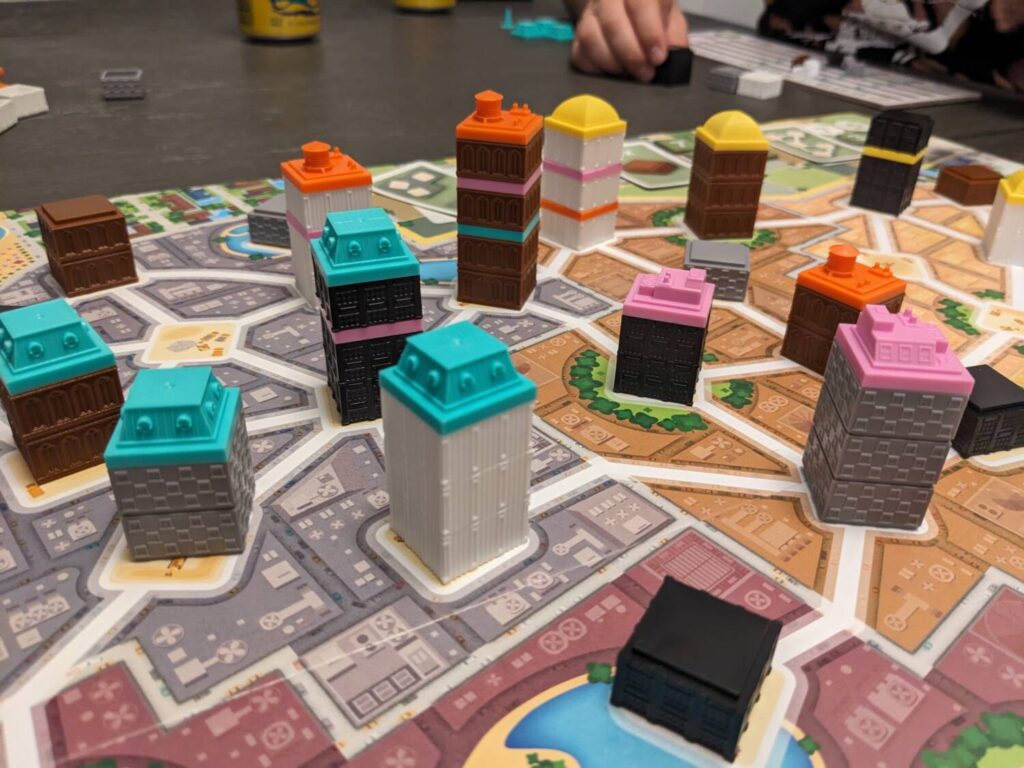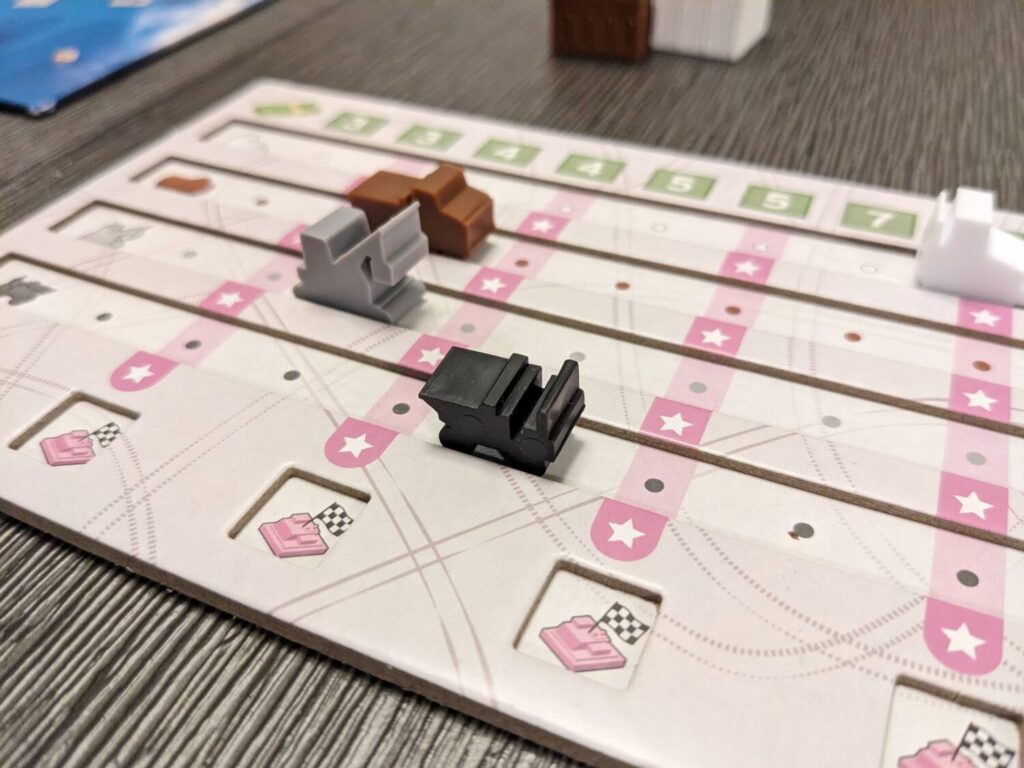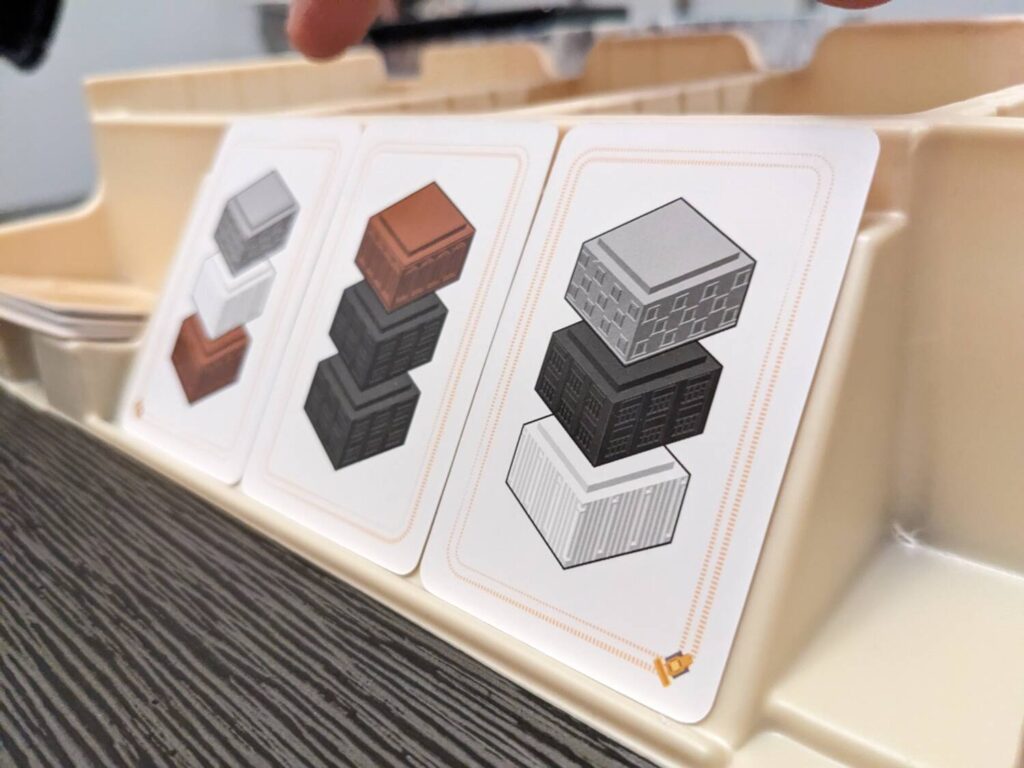Disclosure: Meeple Mountain received a free copy of this product in exchange for an honest, unbiased review. This review is not intended to be an endorsement.
Tower Up (2024, Monolith Board Games) is one of the only games this year where I struggled to pick any holes in its design.
None of the five unique players who joined me for my three review plays (at two, two, and four players) could throw any stones at the game, either. Tower Up is maybe the cleanest design of a tabletop game I have played this year.

Everything is Fantastic
Tower Up is a 2-4 player city building game. It was fantastic as a four-player game, and it was fantastic as a two-player game, thanks to the novel approach to the game’s map size…on the back of the 3-4 player side of the board, half of a normal-sized map is used for the two-player variant, and it offers just as much tension on both sides as players build a city.
The rules overhead is super light, but offers so much depth for a game that didn’t look like it would have that much.
Players have two choices on their turn: draw a card from a three-card market to draft building pieces, or start a new building on the map. When taking a card, players just take all the pieces shown on their card into their personal supply up to a limit of 10 pieces. Occasionally, a card grants fewer pieces but includes a bump on one of the game’s four tracks on the active player’s personal board.
Starting a new building involves placing a piece in an empty space then “paying” one floor (piece) to each building adjacent to the space of the new building. The only rub? The other buildings adjacent to your new building have to be a color different than the one you are starting. Then, after paying floors, you must drop one of your 10 roofs on any building affected by your actions that turn.
Depending on the roof placement, players move up on one of the four tracks (white, gray, brown, black). Each move up a track boosts the end-game value of that track. When all four markers cross certain thresholds, the active player gets a bonus turn. During a turn, if a player’s building activity triggers one of the three public milestones at the top of the board, they take the highest-valued marker for that milestone and add it to their player board, adding to their end-game total.
Those, friends, are all the rules. One of my plays was with my seven-year-old, and he didn’t ask any questions during the game, so Tower Up is absolutely a game you can play with your kids.

The decision space is fantastic. What initially looked like a race to grab as many of the top-value milestone tokens as possible to win (and that’s certainly important) turned into a game where something else became more valuable—finding ways to keep roofs in your player color visible by the end of the game. In addition to milestone and track points, players get a bonus for the number of roofs still serving as roofs when play ends. That’s because the floor payment system often forces a newly-paid floor to live on top of previously-placed roofs, killing off the chance for that former “roof” to score. (Now it’s just a pretty color buried between, say, brown floors.)
Because some building plots are not adjacent to many other spaces, it was always crucial to bury some of your roofs in places where no one else could “roof a roof.” Even my seven-year-old picked up on this, and it was fun to watch him pull off a turn where he collected enough of the appropriate building pieces to cover three of my roofs on a single, late-game action.
The production is fantastic. That starts with a perfect storage solution. One of the two trays holds all the building pieces and card display, along with a holding space for both a draw pile and a discard pile. (OK, OK, fine. There’s one thing that isn’t perfect in Tower Up. The tray that holds cards uses a different holding tray style for the discards, when it should have just used two flat areas to hold a stack of cards. It’s not terrible, but it’s not perfect. Had it only knocked this part out, the trays could have achieved perfection!!!!)
The other storage tray holds all player pieces—roofs, track markers, milestone markers, and the cutest thing in the box, a traffic cone used to mark the number of visible roofs each player has at the end of the game. The track markers are perfect—instead of simple cubes in the right colors, Tower Up opted for small construction vehicles (veeples?) in the four different colors, which are moved up one space each time a player goes up on a track.
The cards are easy to read, and the rulebook is almost luxurious for a game that can be taught to a seven-year-old in five minutes. (The back of the manual also has a rules overview, just in case players forget how to play.)

The playtime is fantastic. Each of my two-player games took less than a half-hour, and my four-player game took 50 minutes. The box says this is a 30-to-45-minute game, and now that I’ve played it three times, I’m inclined to agree.
The scoring system is fantastic. Scores are easy to compute, and scores are calculated in millions of dollars. If your black tracker ends up in the column with the nine, that’s nine million bucks. Add up the total on your four tracks, add the milestone and roof bonus, and voila, ball game.
My son was strangely excited by the idea that his score would be, say, $35 million. “Millions of dollars?” he said at the end of our game. “That’s so cool!” (Love that kid.)
The toy system is fantastic. I know this, because near the end of the game with my son, he asked a simple question.
“Daddy, can we keep this on the table after the game is over? I want to play with it,” he said.
So he did. And he built glorious stacking toys of tall gray and black buildings, then placed different-colored roofs on each tower. Using the track markers, he put construction vehicles on the little white lines that show adjacency to each building space, making it look like our town was chock-full of big-city traffic. He even added the traffic cones to roads that were cut off.

Buy It, Now
Tower Up was one of the easiest five-star reviews I’ve given this year.
It’s fun. It’s interesting. It’s easy to teach. It’s beautiful to look at, especially when games are over. The production is stellar. You can set it up, teach it, play with four players, and tear it down in just under an hour. The 10 milestone cards give each game different goals, with only three of those cards used in any single game. It scales nicely and plays just as well regardless of player count.
Tower Up is a winner. Now, if you’ll excuse me, my son and I have to clear the table of his newly-constructed city before dinner.












If you have to choose one, which one would it be, tower up or cities?